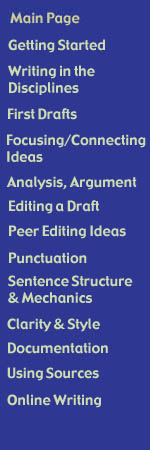

Preparing to Write An Introduction
(printable version here)
While it is impossible to provide advice for every academic subject and every professor's "pet peeves," the advice that follows should assist students preparing introductory paragraphs for many general assignments. Writers should always speak to professors about personal likes/dislikes and the conventions of the field of study.
The Writing Consultants who helped make up this list agree that, in general, these techniques hold true for many courses and assignments.
Types of introductions to avoid:
- The Dictionary Definition: Many papers begin "Webster's defines X as..." and then continue to discuss the topic. This type of introduction has become very stale with faculty, who have seen it thousands of times.
- The "CinemaScope" Intro: These often crop up in introductory history classes. Avoid sweeping panoramas such as "Throughout the march of history, one thing has been true..." or "Many novels have considered the ways in which good people become corrupted by money." These tend to be too general to fully capture a reader's attention. See an example of a revised "cinema scope" intro here.
- Cutting to the Chase too Quickly: It is too easy to go too far while avoiding overly general introductions. Avoid jumping right into a thesis statement and do not try to cover every topic in the first paragraph. It is difficult to say how specific to be in an introduction, but consider the idea that this part of a paper provides "the lay of the land" for a reader who will then know why the paper is worth finishing. Consider an intro a "roadmap" that touches on the points that will be covered in the pape
- Memorable Quotations: Some faculty do not like papers to start with another's words. This overused strategy may be acceptable if a direct quotation sets the stage for what follows and its relevance is discussed in the introduction."Other's quotes are not original"- Ancient Writing Consultant proverb.
Other flaws common to introductions:
The "telegraphic" sentence: Here a writer uses the first person to tell a reader what is going to happen. We have all seen this pattern:
"This essay will consider the development of humor in American Naturalism. My thesis is. . . "
Academic writing tends to adopt a more subtle approach, as in the revised example:
"The Naturalist writers in America, like their European counterparts, rarely flinched in depicting humans as brutal creatures driven by desires venal, animal, and primordial. Forbidden sexuality, gluttony, disease. . . "
Not a cheerful topic, but the tone is correct for these readers.
Good ideas for introductions:
Orienting readers to the topic: Some faculty members will urge witers to "dive right into" the paper. This can lead to trouble if the reader does not know why the writer is beginning where they do.Try to find a balance between engaging and orienting the reader and having too much "fluff".
An introduction is a great test for the writer--it maps the rest of the paper and will quickly show whether the topic is too broad or too complex. When writing the introduction, a writer should imagine themselves as the reader. If they had not read the paper before, what would a reader expect next given what they have already read? Are there topics in the essay that are not briefly mentioned in the introduction? If so, include a mention of these topics.
Focusing the introduction: The goals just mentioned could, if abused, lead a writer to write an introduction that is pages and pages long. Remember, the introduction should not contain every bit of detail in the paper, and it should not include support for a thesis (save that for the body of the paper). An introduction might, however, include the reasons why the writer and reader should care about the topic.
Example of a focused introduction that orients its readers:
The Naturalist writers in America, like their European counterparts, rarely flinched in depicting humans as brutal creatures driven by desires venal, animal, and primordial. Forbidden sexuality, gluttony, disease, avarice, and mental degradation fill the pages of the novels and short stories by these writers of the early 20th century, and such texts now, as then, can shock readers expecting sentimental treatments of marriage, family, and friendship. While the subject matter of this body of work suggests a dark tone, for some writers the Naturalistic universe becomes a playground for dark comedy. One sees that impulse in the situations, narration, language, and denouement of Frank Norris' most famous novel, McTeague.
A reader now expects the paper to talk about Norris' use of humor in an otherwise Naturalistic text. Were the essay to include discussions of other novelists or Norris' other work in more than a contextual way, the reader would be surprised. Were the writer to try to cover all those in the introduction and then write a paper on the topic, it would be huge! Better to pick one aspect of the Naturalism (such as this novel's humor) and stick to it.
Back to 'Getting Started'
Writer's Web | Writing Center | Make
an Appointment | Library
Copyright Info
Checked & proofread, fall 2018, Griffin Myers, Writing Consultant